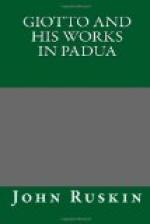Nothing is indeed more notable in the history of art than the exact balance of its point of excellence, in all things, midway between servitude and license. Thus, in choice and treatment of subject it became paralysed among the Byzantines, by being mercilessly confined to a given series of scenes, and to a given mode of representing them. Giotto gave it partial liberty and incipient life; by the artists who succeeded him the range of its scenery was continually extended, and the severity of its style slowly softened to perfection. But the range was still, in some degree, limited by the necessity of its continual subordination to religious purposes; and the style, though softened, was still chaste, and though tender, self-restrained. At last came the period of license: the artist chose his subjects from the lowest scenes of human life, and let loose his passions in their portraiture. And the kingdom of art passed away.
As if to direct us to the observation of this great law, there is a curious visible type of it in the progress of ornamentation in manuscripts, corresponding with the various changes in the higher branch of art. In the course of the 12th and early 13th centuries, the ornamentation, though often full of high feeling and fantasy, is sternly enclosed within limiting border-lines;—at first, severe squares, oblongs, or triangles. As the grace of the ornamentation advances, these border-lines are softened and broken into various curves, and the inner design begins here and there to overpass them. Gradually this emergence becomes more constant, and the lines which thus escape throw themselves into curvatures expressive of the most exquisite concurrence of freedom with self-restraint. At length the restraint vanishes, the freedom changes consequently into license, and the page is covered with exuberant, irregular, and foolish extravagances of leafage and line.
It only remains to be noticed, that the circumstances of the time at which Giotto appeared were peculiarly favourable to the development of genius; owing partly to the simplicity of the methods of practice, and partly to the naivete with which art was commonly regarded. Giotto, like all the great painters of the period, was merely a travelling decorator of walls, at so much a day; having at Florence a bottega, or workshop, for the production and sale of small tempera pictures. There were no such things as “studios” in those days. An artist’s “studies” were over by the time he was eighteen; after that he was a lavoratore, “labourer,” a man who knew his business, and produced certain works of known value for a known price; being troubled with no philosophical abstractions, shutting himself up in no wise for the reception of inspirations; receiving, indeed, a good many, as a matter of course,—just as he received the sunbeams which came in at his window, the light which he worked by;—in either case, without mouthing about it, or much concerning




